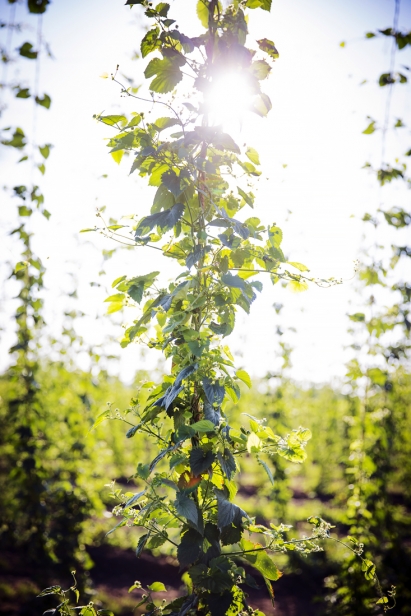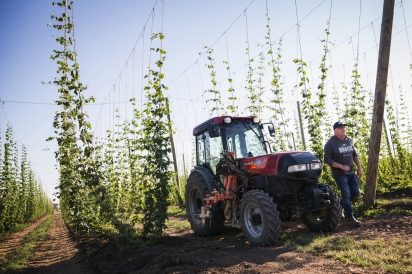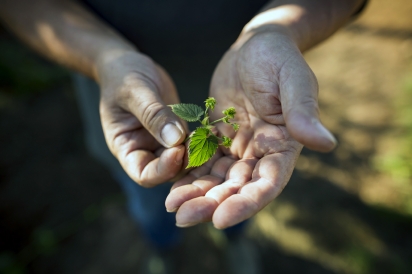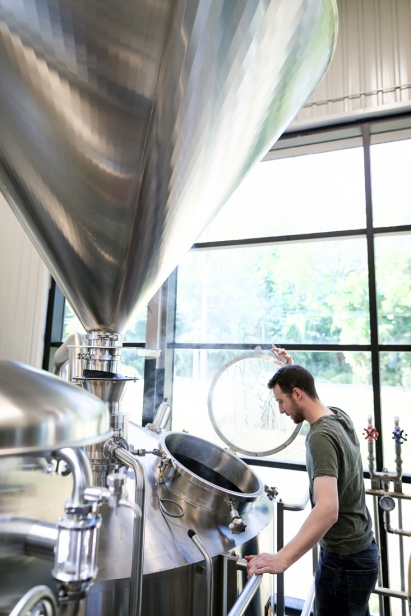The Terroir of Beer
The Niagara region has become well-established for its high-quality vineyards and wines of character and distinction. Home to nearly 100 wineries, the area offers ideal growing conditions, thanks to the warm micro-climate of the Niagara Escarpment. But, beyond wine, Niagara is quickly becoming a hotbed for hops production.
The hop cone — the female flower of the hop plant — is well-known for its use in brewing beer. Either aromatic (for scent) or bitter (for taste), hops are an important ingredient in creating flavourful beer. And, like the wine grape, the hops flower has the ability to capture the local terroir, reflecting the climate, soil and geography of where it was grown.
Hops are by no means a new crop to Ontario — in fact, in the 19th century, hop farming was a thriving industry in the province. But a combination of forces would come to hurt the industry, including ensuing pressures of the prohibition era and the centralization and industrialization of the brewing process. Additionally, pests and disease ravaged yards and closed many hop farms. As a result, Ontario craft brewers have been forced to import most of their hops, primarily from the American northwest and Europe.
But change is brewing. The massive growth of the province’s craft beer industry — now encompassing more than 250 microbreweries — as well as the growing demand for local and fresh ingredients, have encouraged newfound interest in locally produced hops. According to Albert Witteveen, president of the Ontario Hops Grower’s Association, the province currently produces approximately 30 to 40 varieties of hops from 200 acres — a production area expected to double over the next few years. He also predicts that consumer interest will continue to grow as people increasingly seek out new opportunities to taste and experience what the local geography offers.
But, growing hops in Ontario doesn’t come without challenges. The farming itself is expensive. Hops require specialized trellis systems which are pricey to build and maintain, in addition to the cost of picking equipment and an oast house to dry the hops. The plant also requires a significant amount of water and nutrients, so determining where to plant is crucial. And — just like wine — hops take patience. The slow-growing and temperamental crop takes three to four years to mature and produce a product of sufficient quantity and quality.
It’s an investment local breweries, such as Bench Brewing Company in Beamsville, are beginning to embrace. Bench is a brewhouse that has a three-acre hops field onsite. It also boasts a barrel-aging and wild ale program, as well as a taproom, beer garden and food kitchen. Kevin Bailey is the hop field manager and a veteran of Niagara’s grape and wine industry.
In 2015, he was hired by Bench Brewing’s founder, Matt Giffen, bringing nearly 40 years of experience to the hops yard. “After starting this position,” Bailey says, “Matt asked if I knew anything about growing hops — the short answer was no, the long answer was I wanted to learn more about hops and to this day I am still learning. We took several trips to Michigan and Wisconsin and spoke with growers and industry experts to learn the whole process of growing hops.”
In 2016, the brewery purchased an adjoining piece of land to be the future site of the hop yard. To prepare the field, the remains of a former vineyard had to be removed, the land tile-drained and the soil prepared for planting by adding organic materials and manure. The team members then placed the hop poles in the ground, followed by the cabling. They planted four varieties: Cascade, Centennial, Chinook and Willamette, all of which offer different characteristics, from floral and citrusy to piney and spicy.
But, Bailey says, “being a young hops field, time will tell how unique this location will prove in producing Niagara’s best hops. We are keeping our on-site hops field at its current size of three acres for the short term.”
There has been immense growth of hop planting in Niagara and surrounding regions over the last two years, Bailey explains. “We are really excited to see other farmers creating new hop fields with the idea that we will purchase these locally grown hops for our beer,” he says. “We can help with advice on site preparation, planting and hops field management as well as ideal varietal selection to promote a well-balanced and viable industry. It’s proving to be a very symbiotic relationship that will hopefully create a new and exciting agricultural market in the region much like it was in the early 1900s.”
Roger Vail, a Vineland native, started Vailmont Vineyards with his wife in 1983. What began as a 10-acre parcel of land has now expanded to 600 acres of grapes. Vail considers his son-in-law, Joe Snihur, an integral part of the company’s growth. When Snihur suggested a hops yard, Vail explains, “we listened and were skeptical at first. But he presented the facts and the idea became very interesting.” Two years ago, Snihur Ridge (Vailmont’shop farm) was born.
“Before we jumped at this with both feet,” Vail says, “we strongly suggested that we find a brewery to work with. Joe and I went to visit a brewery who we thought would be a great fit and after our first meeting we left feeling dejected as they did not seem interested in working with us.” But a year later, the brewery reconsidered and called them up. “We were shocked and pleased — and of course scared,” Vail remembers.
While Ontario is not considered a large hop market, Vail estimates the annual hop imports are worth more than $41-million. “We felt that we should not only supply for the small guy breweries, but also look at taking back some of the share imported for local grown,” he says.
“We [had] all the equipment, knowledge, savvy and push from our many years of grape growing and as first-generation growers,” Vail explains, but the hardest part about getting the hop yard off the ground was getting financial backing. After a lot of time and meetings, Vail’s family received startup support and now they're reviewing and updating plans for potential expansion.
Vail also believes the conversation about local hops is changing.
“Terroir is always talked about with grapes and wine, but seldom talked about when discussing hops, and this is another area open for future discussion.” While most hops are grown in deep, sandy loam soils, he believes that the flavour profiles of hops grown on clay will be superior, creating a better tasting beer.
Despite the challenges and uncertainty of producing hops in Ontario, Vail remains decidedly optimistic. “In the end, are we excited? Yes. Are we in this for the long haul? Yes. Have we stopped dreaming of other areas to expand into? No!”
And it's that kind of attitude that’s fortifying the relationship between the local grower, brewer and beer drinker — something that Ontarians should be very excited about.
Bench Brewing Company
3991 King St., Beamsville, Ont.
benchbrewing.com | 905.562.3991 | @benchbrewing
Vailmont Vineyards Ltd. & Snihur Ridge
2880 Tintern Rd., Vineland Ont.
vailmontvineyards.com | 905.563.2880











